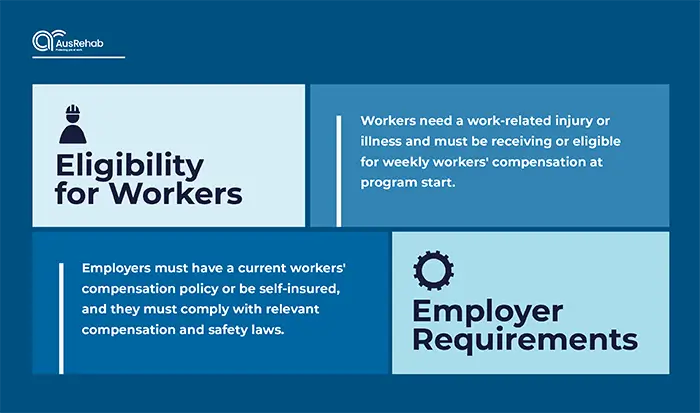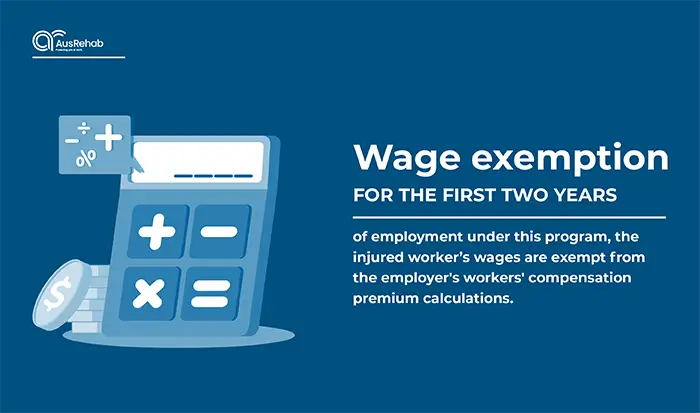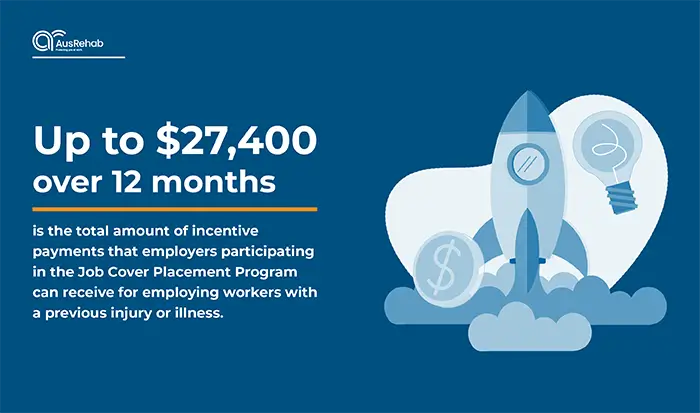May 07, 2024 • 9 min read
Work Trial vs. JobCover6 vs. JCPP: What's the Difference?
All three of SIRA’s schemes aim to return an injured worker to gainful employment, but each program packs a punch in their own way. Keep reading to find out how they differ and which scheme is most relevant for you.


One of the biggest goals of workplace rehab is to return the worker to work in a swift and timely manner. However, recovering workers often find themselves at a stage where they’ve not fully regained pre-injury capacity levels but are able to work alternative duties.
Enter these three NSW Government-supported schemes: Work trial, JobCover6 and Job Cover Placement Program (JCPP). While they can all be said to serve the same purpose, each program has different eligibility criteria, incentives and limits for both the trainee and host employer.
Overview of Work Trial
A work trial offers a structured, short-term work experience for a trainee with a host employer for up to 12 weeks. Typically, a work trial lasts between 4 to 5 weeks, but the duration can be adjusted based on what the trainee needs and the employer’s availability.
Being enrolled in a work trial helps the worker to remain active and acquire new skills, which is key for a constructive post-injury rehabilitation process.
This program is relevant when:
- the pre-injury employer is unable to provide alternative duties within the worker’s current capacity; or
- the worker is returning to work with a new employer and requires on-the-job training
NOTE: A worker is known as a trainee and not a worker in a work trial program. This discrepancy is significant as trainees have no claim against the host employer’s workers compensation insurance. If the trainee experiences changes to their existing injury or sustains a new injury during the work trial period, this will be managed by the insurer as part of the workers claim.
Work Trial Eligibility
Trainee Eligibility
A worker is eligible if they:
- are receiving, or are entitled to receive, weekly payments under the Workers Compensation Act 1987
- have capacity to work, but their pre-injury employer is unable to provide suitable work
- have not accepted a commutation or work injury damages settlement
Employer Eligibility
An employer may be eligible if they:
- have no workers compensation liability to the trainee
- have no current employer/employee relationship with the trainee
- hold a current workers compensation policy with an insurer or a self-insurer’s licence
- are not grouped with the pre-injury employer for workers compensation insurance or insured under the same group self-insurer licence as the pre-injury employer
- have professional indemnity, public liability and motor vehicle insurance coverage where necessary
- adhere to relevant workers compensation and workplace health and safety laws

Work Trial Benefits
Work trials are designed to be mutually beneficial. They provide distinct advantages that help workers regain their professional footing, while also allowing employers to strategically enhance their workforce.
Benefits for Trainees
- Getting Your Foot in the Door: Whether returning to a familiar field or exploring a new industry, a work trial provides the perfect opportunity to re-enter the workforce.
- Skills Refresh: For those who haven’t worked in a while, a work trial is a chance to refresh old skills and get used to daily work routines again.
- Learning and Upskilling: Every work trial is a learning opportunity. You’ll meet new people and learn new skills, broadening your professional abilities.
- Demonstrate Abilities: Showcase your skills in the work setting and potentially secure long-term employment with your host employer.
- Building Relationships: Develop positive work relationships and earn references that will be invaluable in your future job searches.
- Networking: Use this time to tap into the host employer’s network, potentially opening doors to future job opportunities.
- Boosting Confidence: Being part of a work trial can significantly increase your confidence, making the transition back to regular employment smoother.
Benefits for Host Employers

- Access to Specialised Skills: Employers can bring in workers with specific skill sets needed for short-term projects, benefiting their business without a long-term commitment.
- Evaluating Fit: A work trial allows employers to assess a worker’s performance, work ethic, and how well they fit into the company culture before making a decision on permanent employment.
- Cost Savings: You won’t pay the worker’s salary during the trial because the insurance company does.
- Customised Roles: Employers have the flexibility to create short-term roles tailored to the worker’s skills, experience, and physical capabilities.
- Limited Liability: Employers are generally not liable for any aggravation or recurrence of the old worker’s injuries during the work trial, as safety assessments and responsibilities are clearly defined and managed.
- Assured Safety: A rehabilitation consultant conducts a workplace assessment to ensure that all tasks and duties are suitable and safe for the injured worker.
Implementing a Successful Work Trial
For a work trial to be successful, it’s essential for employers to fully understand their needs and effectively communicate the benefits to potential participants. Building trust through transparency about the program and clear, accurate descriptions of the worker’s capabilities and restrictions sets a strong foundation.
By ensuring all parties are informed and comfortable with the arrangement, work trials can facilitate successful re-entry into the workforce for injured workers while providing significant benefits to employers.
Overview of JobCover6
JobCover6 helps workers find work with a new employer. This program supports employers in offering employment for up to 6 months to a worker who is:
- recovering from a work-related injury or illness
- ready to return to work
- unable to secure employment with their pre-injury employer
Employers utilising JobCover6 have the option to extend into the JCPP at the end of the program period.
JobCover6 Eligibility
Worker Eligibility
Just like the eligibility criteria for work trials, a worker is eligible for JobCover6 if they:
- are receiving, or are entitled to receive, weekly payments under the Workers Compensation Act 1987
- have capacity to work and are looking for new employment
- have not accepted a commutation or work injury damages settlement
Employer Eligibility
An employer may be eligible if they:
- have no workers compensation liability to the worker
- are not the worker’s pre-injury employer
- have offered employment to a worker for an agreed period of up to 6 months, for a minimum of 64 paid hours per month (exceptions can be made for fewer hours in the initial period if can be shown that the worker will progress to meet this requirement reasonably soon)
- hold a current workers compensation policy with an insurer or a self-insurer’s licence
- are not grouped with the pre-injury employer for workers compensation insurance or insured under the same group self-insurer licence as the pre-injury employer
- have professional indemnity, public liability and motor vehicle insurance coverage where necessary
- can demonstrate adherence to relevant workers compensation and workplace health and safety laws
- are not receiving any other wage subsidy for the worker
JobCover6 Eligibility
Benefits for Workers
JobCover6 and JCPP are a step up the ladder from work trials because in these two programs, the worker is entitled to a paid wage. Hence, workers enrolled in JobCover6 benefit by getting:
- Paid Employment: Fair remuneration for their time and labour can give workers a sense of job satisfaction and improved financial security.
- Opportunity for Full-time Work: The program accommodates a range of employment arrangement and effectively paves the way for the worker to return fully to work.
- Enhanced Well-being: Through this program, the worker can regain confidence in themselves and their work abilities, especially since they’ve had to pivot to a new employer.
Benefits for Employers
Employers who participate in this program obtain:
- incentive payments of up to $10,400 over a period of up to 6 months, with a weekly maximum of $400
- exemption of the worker’s wages from the employer’s workers compensation premium calculation for two years
- no liability for any worsening or recurrence of the worker’s existing injury for up to two years
These benefits can be used individually, in a combination, or as a total package.
Overview of Job Cover Placement Program (JCPP)
Similar to JobCover6, the JCPP is designed to encourage employers to offer ongoing paid employment to injured workers who are still recovering but cannot return to work with their pre-injury employer.
The program gives employers financial incentives that offset the cost of engaging an injured worker. The employer would also gain a highly motivated worker who can contribute productively to the company in the process.
JCPP Eligibility
Worker Eligibility
Just like before, a worker is eligible if they:
- are receiving, or are entitled to receive, weekly payments under the Workers Compensation Act 1987
- have capacity to work, but their pre-injury employer is unable to provide suitable work
- have not accepted a commutation or work injury damages settlement
Employer Eligibility
An employer may be eligible if they:
- have no workers compensation liability to the worker
- are not the worker’s pre-injury employer
- have offered employment to a worker for at least 12 months, for a minimum of 64 paid hours per month (exceptions can be made for fewer hours in the initial period if can be shown that the worker will progress to meet this requirement reasonably soon)
- hold a current workers compensation policy with an insurer or a self-insurer’s licence
- are not grouped with the pre-injury employer for workers compensation insurance or insured under the same group self-insurer licence as the pre-injury employer
- have professional indemnity, public liability and motor vehicle insurance coverage where necessary
- can demonstrate adherence to relevant workers compensation and workplace health and safety laws
- are not receiving any other wage subsidy for the worker
JCPP Benefits
Benefits for Injured Workers
The most significant advantage JCPP has over its two sister programs is guaranteed paid employment for at least a year.
Naturally, this means a greater sense of financial security, improved overall well-being, as well as the opportunity to eventually return to work with this employer.
Benefits for Employers

“If the injured worker experiences any aggravation or recurrence of their injury within the first two years, the employer is not responsible for the associated costs. These costs are covered by the worker’s original claim.”
Employers gain considerable benefits such as:
- incentive payments of up to $27,400 during the first year to offset the costs of the worker’s wages
- exemption of the worker’s wages from the employer’s workers compensation premium calculation for two years
- no liability for any worsening or recurrence of the worker’s existing injury during the first two years of employment
These benefits can be used individually, in a combination, or as a total package.
The Attractiveness of JCPP
The Job Cover Placement Program fosters a mutually beneficial situation. It motivates employers to offer job opportunities to injured workers, helping them return to the workforce. At the same time, it provides significant benefits and protections for the employers involved. This program goes beyond simply providing jobs; it’s about creating a supportive workplace that prioritises the health and recovery of its workers.
FAQs
The Job Cover Placement Program is versatile and can be applied to a variety of roles across different industries. The key requirement is that the role must accommodate the specific needs of an individual with a pre-existing injury or health condition and must be sustainable and meaningful employment. Positions can be full-time, part-time, or casual, as long as they meet the minimum hours requirement.
*The details in this article were correct and current when it was written. However, changes in business practices, policies, and other pertinent areas may have occurred since then. Readers should confirm the current validity of the content on their own.


Want to Make a Change? Share with Anyone, Anywhere.